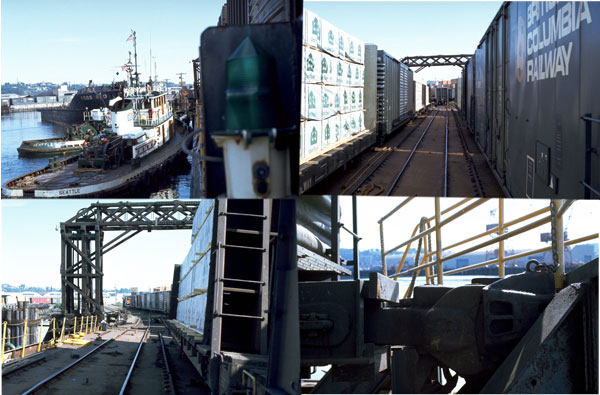PUGET SOUND BARGES
Over time, the Milwaukee Road ran railroad car barges to several Puget Sound destinations including Bellingham, Port Gamble and Shelton. By my time there were two principal destinations: Port Townsend and North Vancouver, B.C.
Port Townsend was the entry point to the Coast Division, 14th Sub, the 50 mile long Port Angeles line. The two barges in this service were the Milwaukee owned three track (15 car) MT 20 and MT 21. Foss Tug provided tug service for the barges. The Seattle barge apron at Pier 27 was set up for these two barges, with three tracks on the apron that corresponded to the three tracks on each barge. The barge apron at Port Townsend was the same.
North Vancouver B.C., via barge, was the Milwaukee Road's direct connection with the British Columbia Railway. This was lucrative long-haul finished forest products traffic; all loads to Seattle, all mtys to North Vancouver. Reporting marks for boxcars and bulkhead flats in this service included: PGE (Pacific Great Eastern was the original name of the British Columbia Railway), PGER, BCR, BCOL, and BCIT. The BCIT cars (British Columbia International Service) were specially dedicated to this British Columbia - Milwaukee Road connection. There were also private reporting marks, including MacMillan Bloedel and Findlay International. Two barges were principally used for this service: the four track Foss 250 (16 cars) and the five track Foss 252 (19 cars; with switch to the fifth track on board the barge). Another four track barge, the GA 900, was in occasional service. To load and unload, these barges had to be laterally shifted by the tugs to work all four tracks.
The barges were worked by Seattle Yard engines. Access to the waterfront yard was either via the Argo Interchange to the south, or the B.N. waterfront man to the north, then a reverse movement to the Waterfront (Whatcom) Yard. Usually all four barges were worked five days a week. This provided the main part of the work for two yard jobs each day.
Unloading a British Columbia Railway barge
How to work a barge
- Bring the yard engine into Pier 27 and tie on to whatever idlers are at hand (keep engine off apron). Cut air into idlers. AIR MUST BE USED AT ALL TIMES.
- Tie idlers to first track to be pulled. On British Columbia Railway four track Foss barges, this will be an inside track. On three track Port Townsend Milwaukee Road barges, this will be an outside track. Cut in air. After pumping up air, field man will release handbrakes on each car (bargemen have already knocked off all track blocks). Field man will then assume position at bow of barge, get pin on hand signal and uncouple drag from barge.
- Double pulled cut to opposite outside track (on three track barges, double to other outside track). Pump up air, knock off handbrakes, uncouple, and pull as in two above.
- Double drag to remaining outside track (on three track barges, double to inside track).
- Take drag across Alaskan Way S., tie to, or shove up, the waterfront main.
- Reach into the yard, grab drag to be loaded, then load barge in reverse order of procedure above.
- Shift four track barge (three track barge is finished), pull and reload last track.
Chainsaw Material
COAST DIVISION
SEATTLE YARD- Survivin' the Night
- Puget Sound Barges
- Switchin' & Trampin'
- Flat Switching
- Black River Yard & The P.C.R.R.
- Road Extra Board
- Tacoma Roundhouse
- Tacoma Junction
- Joint Line: Superiority of Trains
- Joint Line: Automatic Block Signals (ABS)
- Mainline: Othello
- Mainline: Extra 194 West
- Mainline: Extra 156 East
- Mainline: Beverly Depot
- Mainline: Columbia River Bridge, Boylston Tunnel, Renslow Trestle
- Mainline: Snoqualmie Pass
- Mainline: Cle Elum
- Mainline: Work Trains and Wreckers
- South Line: Rule 99 Territory
- Burlington Northern Pacific Division Third Sub: Centralized Traffic Control (CTC)
- Portland Trains
- Hoquiam Turn
- Tacoma and Eastern Railway (12th Sub): Mineral Turn
- Tacoma and Eastern Railway (12th Sub): Morton Local
- Olympic Peninsula (14th Sub): Port Angeles to Portland
Join the Milwaukee Road Historical Association and MilWest

